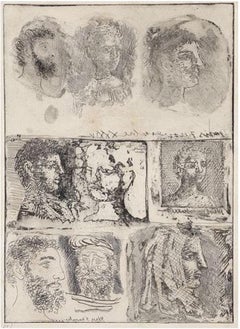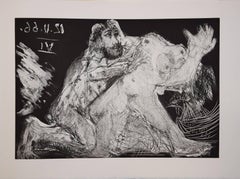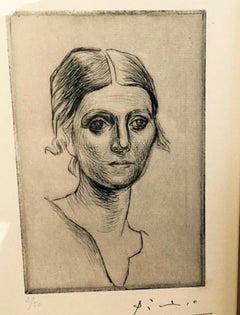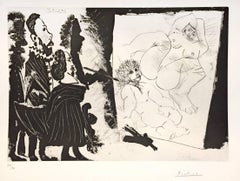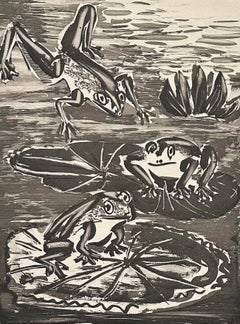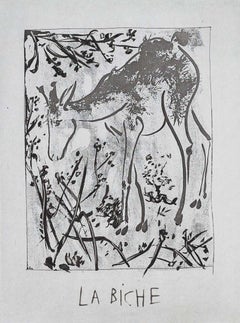Art by Medium: Drypoint
to
11
6
17
Overall Width
to
Overall Height
to
35
3
1
1
3
2
1
5
2
25
1
27
7
21
20
13
7
7
6
6
4
3
2
2
2
2
1
1
1
1
1
1
1
1,352
359
201
192
105
127
36
35
31
24
19
8
23
11
Medium: Drypoint
Artist: Pablo Picasso
Feuille d'etudes Techniques: Neuf Tetes
Located in New York, NY
Etching and drypoint on laid paper, 1934. With Picasso's ink stamped signature lower right, and numbered 29/50 in pencil lower left.
Image 12.25 x 8.75 inches, full sheet 19.5 x 13...
Category
1930s Modern Art by Medium: Drypoint
Materials
Etching, Drypoint
Le Cocu Magnifique - Complete Suite of Etchings by Pablo Picasso - 1968
Located in Roma, IT
In-folio Oblong
Dimensions : 29x39 cm.
Paris
Atelier Crommelynck
1968
Edition of 200 copies including 12 original out-of-text etchings (7 etchings, 4 etchings and acquatint and 1 e...
Category
1960s Cubist Art by Medium: Drypoint
Materials
Drypoint, Etching, Aquatint
Portrait d'Olga Picasso (Bloch 37; Baer 57)
Located in New York, NY
Drypoint etching, 1919-1920 on laid paper, printed later, 1961
#3 From the edition of 50
Signature Stamp Picasso, lower right and numbered, lower left
plate: 6 by 3 7/8 in (151 by...
Category
1920s Modern Art by Medium: Drypoint
Materials
Drypoint, Etching
Patron et sa Suite en Visite à l’Atelier - Etching by P. Picasso - 1968
Located in Roma, IT
Hand signed. Edition 35 of 50.
From the Serie “Les 347”, table no. 110.
Perfect impression on vélin blanc, very fresh and with sheet in full margins and perfect conditions, numbered ...
Category
1960s Cubist Art by Medium: Drypoint
Materials
Drypoint, Aquatint
La Grenouille (The Frog), from Buffon's l'Histoire Naturelle
Located in Washington, DC
Artist: Pablo Picasso
Title: Le Grenouille (The Frog), from Buffon's l'Histoire Naturelle
Medium: Original etching with sugar-lift aquatint and drypoint on Vidalon paper with Vollard...
Category
1940s Cubist Art by Medium: Drypoint
Materials
Drypoint, Etching, Aquatint
The Deer, 1942 (Histoire Naturelle - Textes de Buffon, B.336)
Located in Greenwich, CT
The Deer is an aquatint and drypoint print on chine from one of the deluxe copies of Picasso's 1942 Histoire Naturelle - Textes de Buffon series. The image size is 10.5 x 8.15 inches, unsigned as issued, and framed in a contemporary silver and gray moulding. One of about 36 prints that exist with Picasso's remarqued title in French, from the edition of 262 (there were 226 portfolios, some with additional sets on varying papers).
Catalogue - Cramer #37
The exceptional etchings from Picasso’s Histoire Naturelle – Textes de Buffon are a masterful combination of sugar-lift aquatint and drypoint, showcasing a full range of gray tonalities. The etchings of animals, birds and insects are considered some of the most beautiful and most unusual examples of Picasso’s graphic work.
Roger Lacourière, Picasso’s master printer, pulled the prints for each etching between 1939-1942. It was Lacourière who taught Picasso the sugar-lift aquatint technique which allowed him to mimic the effect of brushstrokes in these etched images. Picasso first explored the technique in his plates for the Vollard Suite, but it was in the creation of the Buffon images that he fully realized its stunning, painterly potential.
For the edition, 226 portfolios were produced with the first thirty-six counting as deluxe compilations. These rare deluxe sets were on diverse papers (chine, japon or vergé ancien) and each included a complete additional suite showing Picasso’s title remarques along the bottom. As such, the remarqued versions of the prints are quite rare with just thirty-six of each produced for the edition (with the exception of The Wolf which is never remarqued – the image always fills the entire etching plate).
These prints are based on the writings of French naturalist Georges-Louis Leclerc, Comte de Buffon, who extensively documented the natural world in his monumental work Histoire Naturelle. Picasso’s association with the project to illustrate parts of the Buffon came during a tumultuous time in European history – the prelude to, and early years of, World War II. As the continent was ravaged, Picasso lived through the disaster in Paris, which the Germans occupied in 1940. These prints could be seen as a political statement – Picasso channeling his artistic expression into a form of resistance art...
Category
20th Century Modern Art by Medium: Drypoint
Materials
Drypoint, Aquatint
Le peintre au cirque
Located in Wien, 9
- Plate 55 from the Suite 156
- with stamp signature
- dated in the plate 2.3.70
- edition 26/50
- cat. raisonné Bloch 1910
Category
1970s Modern Art by Medium: Drypoint
Materials
Drypoint, Etching
Untitled, 1971
Located in Wien, 9
- Plate 118 from the Suite 156
- edition 48/50
- stamp signature
- dated in the plate 17.5.71
- cat. raisonné Bloch 1973; cat. raisonné Baer 1982
Category
1970s Modern Art by Medium: Drypoint
Materials
Drypoint, Etching
The Mother Hen, 1942 (Histoire Naturelle - Textes de Buffon, B.345)
Located in Greenwich, CT
The Mother Hen is an aquatint and drypoint print on chine from one of the deluxe copies of Picasso's 1942 Histoire Naturelle - Textes de Buffon series. The image size is 10.6 x 8 inc...
Category
20th Century Modern Art by Medium: Drypoint
Materials
Drypoint, Aquatint
The Pigeon, 1942 (Histoire Naturelle - Textes de Buffon, B.347)
Located in Greenwich, CT
The Pigeon is an aquatint and drypoint print on chine from one of the deluxe copies of Picasso's 1942 Histoire Naturelle - Textes de Buffon series. The image size is 10.75x 8 inches, unsigned as issued, and framed in a contemporary silver and gray moulding. One of about 36 prints that exist with Picasso's remarqued title in French, from the edition of 262 (there were 226 portfolios, some with additional sets on varying papers).
Catalogue - Cramer #37
The exceptional etchings from Picasso’s Histoire Naturelle – Textes de Buffon are a masterful combination of sugar-lift aquatint and drypoint, showcasing a full range of gray tonalities. The etchings of animals, birds and insects are considered some of the most beautiful and most unusual examples of Picasso’s graphic work.
Roger Lacourière, Picasso’s master printer, pulled the prints for each etching between 1939-1942. It was Lacourière who taught Picasso the sugar-lift aquatint technique which allowed him to mimic the effect of brushstrokes in these etched images. Picasso first explored the technique in his plates for the Vollard Suite, but it was in the creation of the Buffon images that he fully realized its stunning, painterly potential.
For the edition, 226 portfolios were produced with the first thirty-six counting as deluxe compilations. These rare deluxe sets were on diverse papers (chine, japon or vergé ancien) and each included a complete additional suite showing Picasso’s title remarques along the bottom. As such, the remarqued versions of the prints are quite rare with just thirty-six of each produced for the edition (with the exception of The Wolf which is never remarqued – the image always fills the entire etching plate).
These prints are based on the writings of French naturalist Georges-Louis Leclerc, Comte de Buffon, who extensively documented the natural world in his monumental work Histoire Naturelle. Picasso’s association with the project to illustrate parts of the Buffon came during a tumultuous time in European history – the prelude to, and early years of, World War II. As the continent was ravaged, Picasso lived through the disaster in Paris, which the Germans occupied in 1940. These prints could be seen as a political statement – Picasso channeling his artistic expression into a form of resistance art...
Category
20th Century Modern Art by Medium: Drypoint
Materials
Drypoint, Aquatint
Le Viol II
Located in Wien, 9
- handsigned on the lower right
- dated and unreadable inscripted in the plate
- from the Suite Vollard
- plate size: 19,5 x 27,6 cm; sheetsize: 34 x 44,5 cm
- edition of 260, unnumb...
Category
1930s Modern Art by Medium: Drypoint
Materials
Drypoint, Etching, Aquatint
The Sparrow Hawk, 1942 (Histoire Naturelle - Textes de Buffon, B.342)
Located in Greenwich, CT
The Sparrow Hawk is an aquatint and drypoint print on chine from one of the deluxe copies of Picasso's 1942 Histoire Naturelle - Textes de Buffon series. The image size is 10.5 x 8 inches, unsigned as issued, and framed in a contemporary silver and gray moulding. One of about 36 prints that exist with Picasso's remarqued title in French, from the edition of 262 (there were 226 portfolios, some with additional sets on varying papers).
Catalogue - Cramer #37
The exceptional etchings from Picasso’s Histoire Naturelle – Textes de Buffon are a masterful combination of sugar-lift aquatint and drypoint, showcasing a full range of gray tonalities. The etchings of animals, birds and insects are considered some of the most beautiful and most unusual examples of Picasso’s graphic work.
Roger Lacourière, Picasso’s master printer, pulled the prints for each etching between 1939-1942. It was Lacourière who taught Picasso the sugar-lift aquatint technique which allowed him to mimic the effect of brushstrokes in these etched images. Picasso first explored the technique in his plates for the Vollard Suite, but it was in the creation of the Buffon images that he fully realized its stunning, painterly potential.
For the edition, 226 portfolios were produced with the first thirty-six counting as deluxe compilations. These rare deluxe sets were on diverse papers (chine, japon or vergé ancien) and each included a complete additional suite showing Picasso’s title remarques along the bottom. As such, the remarqued versions of the prints are quite rare with just thirty-six of each produced for the edition (with the exception of The Wolf which is never remarqued – the image always fills the entire etching plate).
These prints are based on the writings of French naturalist Georges-Louis Leclerc, Comte de Buffon, who extensively documented the natural world in his monumental work Histoire Naturelle. Picasso’s association with the project to illustrate parts of the Buffon came during a tumultuous time in European history – the prelude to, and early years of, World War II. As the continent was ravaged, Picasso lived through the disaster in Paris, which the Germans occupied in 1940. These prints could be seen as a political statement – Picasso channeling his artistic expression into a form of resistance art...
Category
20th Century Modern Art by Medium: Drypoint
Materials
Drypoint, Aquatint
The Monkey, 1942 (Histoire Naturelle - Textes de Buffon, B.339)
Located in Greenwich, CT
The Monkey is an aquatint and drypoint print on chine from one of the deluxe copies of Picasso's 1942 Histoire Naturelle - Textes de Buffon series. The image size is 10.5 x 7.9 inche...
Category
20th Century Modern Art by Medium: Drypoint
Materials
Drypoint, Aquatint
The Goldfinch, 1942 (Histoire Naturelle - Textes de Buffon, B.348 )
Located in Greenwich, CT
The Goldfinch is an aquatint and drypoint print on chine from one of the deluxe copies of Picasso's 1942 Histoire Naturelle - Textes de Buffon series. The image size is 11.2 x 8.25 inches, unsigned as issued, and framed in a contemporary silver and gray moulding. One of about 36 prints that exist with Picasso's remarqued title in French, from the edition of 262 (there were 226 portfolios, some with additional sets on varying papers).
Catalogue - Cramer #37
The exceptional etchings from Picasso’s Histoire Naturelle – Textes de Buffon are a masterful combination of sugar-lift aquatint and drypoint, showcasing a full range of gray tonalities. The etchings of animals, birds and insects are considered some of the most beautiful and most unusual examples of Picasso’s graphic work.
Roger Lacourière, Picasso’s master printer, pulled the prints for each etching between 1939-1942. It was Lacourière who taught Picasso the sugar-lift aquatint technique which allowed him to mimic the effect of brushstrokes in these etched images. Picasso first explored the technique in his plates for the Vollard Suite, but it was in the creation of the Buffon images that he fully realized its stunning, painterly potential.
For the edition, 226 portfolios were produced with the first thirty-six counting as deluxe compilations. These rare deluxe sets were on diverse papers (chine, japon or vergé ancien) and each included a complete additional suite showing Picasso’s title remarques along the bottom. As such, the remarqued versions of the prints are quite rare with just thirty-six of each produced for the edition (with the exception of The Wolf which is never remarqued – the image always fills the entire etching plate).
These prints are based on the writings of French naturalist Georges-Louis Leclerc, Comte de Buffon, who extensively documented the natural world in his monumental work Histoire Naturelle. Picasso’s association with the project to illustrate parts of the Buffon came during a tumultuous time in European history – the prelude to, and early years of, World War II. As the continent was ravaged, Picasso lived through the disaster in Paris, which the Germans occupied in 1940. These prints could be seen as a political statement – Picasso channeling his artistic expression into a form of resistance art...
Category
20th Century Modern Art by Medium: Drypoint
Materials
Drypoint, Aquatint
The White Eagle, 1942 (Histoire Naturelle - Textes de Buffon, B.340)
Located in Greenwich, CT
The White Eagle is an aquatint and drypoint print on chine from one of the deluxe copies of Picasso's 1942 Histoire Naturelle - Textes de Buffon series. The image size is 10.5 x 8.15 inches, unsigned as issued, and framed in a contemporary silver and gray moulding. One of about 36 prints that exist with Picasso's remarqued title in French, from the edition of 262 (there were 226 portfolios, some with additional sets on varying papers).
Catalogue - Cramer #37
The exceptional etchings from Picasso’s Histoire Naturelle – Textes de Buffon are a masterful combination of sugar-lift aquatint and drypoint, showcasing a full range of gray tonalities. The etchings of animals, birds and insects are considered some of the most beautiful and most unusual examples of Picasso’s graphic work.
Roger Lacourière, Picasso’s master printer, pulled the prints for each etching between 1939-1942. It was Lacourière who taught Picasso the sugar-lift aquatint technique which allowed him to mimic the effect of brushstrokes in these etched images. Picasso first explored the technique in his plates for the Vollard Suite, but it was in the creation of the Buffon images that he fully realized its stunning, painterly potential.
For the edition, 226 portfolios were produced with the first thirty-six counting as deluxe compilations. These rare deluxe sets were on diverse papers (chine, japon or vergé ancien) and each included a complete additional suite showing Picasso’s title remarques along the bottom. As such, the remarqued versions of the prints are quite rare with just thirty-six of each produced for the edition (with the exception of The Wolf which is never remarqued – the image always fills the entire etching plate).
These prints are based on the writings of French naturalist Georges-Louis Leclerc, Comte de Buffon, who extensively documented the natural world in his monumental work Histoire Naturelle. Picasso’s association with the project to illustrate parts of the Buffon came during a tumultuous time in European history – the prelude to, and early years of, World War II. As the continent was ravaged, Picasso lived through the disaster in Paris, which the Germans occupied in 1940. These prints could be seen as a political statement – Picasso channeling his artistic expression into a form of resistance art...
Category
20th Century Modern Art by Medium: Drypoint
Materials
Drypoint, Aquatint
The Lobster, 1942 (Histoire Naturelle - Textes de Buffon, B.352)
Located in Greenwich, CT
The Lobster is an aquatint and drypoint print on chine from one of the deluxe copies of Picasso's 1942 Histoire Naturelle - Textes de Buffon series. The image size is 10.6 x 7.9 inches, unsigned as issued, and framed in a contemporary silver and gray moulding. One of about 36 prints that exist with Picasso's remarqued title in French, from the edition of 262 (there were 226 portfolios, some with additional sets on varying papers).
Catalogue - Cramer #37
The exceptional etchings from Picasso’s Histoire Naturelle – Textes de Buffon are a masterful combination of sugar-lift aquatint and drypoint, showcasing a full range of gray tonalities. The etchings of animals, birds and insects are considered some of the most beautiful and most unusual examples of Picasso’s graphic work.
Roger Lacourière, Picasso’s master printer, pulled the prints for each etching between 1939-1942. It was Lacourière who taught Picasso the sugar-lift aquatint technique which allowed him to mimic the effect of brushstrokes in these etched images. Picasso first explored the technique in his plates for the Vollard Suite, but it was in the creation of the Buffon images that he fully realized its stunning, painterly potential.
For the edition, 226 portfolios were produced with the first thirty-six counting as deluxe compilations. These rare deluxe sets were on diverse papers (chine, japon or vergé ancien) and each included a complete additional suite showing Picasso’s title remarques along the bottom. As such, the remarqued versions of the prints are quite rare with just thirty-six of each produced for the edition (with the exception of The Wolf which is never remarqued – the image always fills the entire etching plate).
These prints are based on the writings of French naturalist Georges-Louis Leclerc, Comte de Buffon, who extensively documented the natural world in his monumental work Histoire Naturelle. Picasso’s association with the project to illustrate parts of the Buffon came during a tumultuous time in European history – the prelude to, and early years of, World War II. As the continent was ravaged, Picasso lived through the disaster in Paris, which the Germans occupied in 1940. These prints could be seen as a political statement – Picasso channeling his artistic expression into a form of resistance art...
Category
20th Century Modern Art by Medium: Drypoint
Materials
Drypoint, Aquatint
L'atelier de Cannes (first state)
Located in OPOLE, PL
Pablo Picasso (1881-1973) - L'atelier de Cannes (The Cannes Studio)
Lithograph from 1956.
The edition of 275.
Dated in the plate at the upper left: “7.4.56”.
Dimensions of work: ...
Category
20th Century Modern Art by Medium: Drypoint
Materials
Drypoint, Etching
Painter in front of one of Raphael's Three Graces..., from: Series 347
Located in London, GB
This drypoint, aquatint with scraper is hand signed in pencil by the artist “Picasso” at the lower right margin. It is dated in the plate “5.8.68.VI.”
It is also hand numbered in pen...
Category
1960s Modern Art by Medium: Drypoint
Materials
Aquatint, Drypoint
Étreinte I
Located in OPOLE, PL
Pablo Picasso (1881-1973) - Étreinte I
Drypoint etching from 1963.
The edition of 47/50.
Dimensions of work: 59 x 76 cm.
Hand signed.
Publisher: Galerie Louise Leiris, Paris.
R...
Category
1960s Modern Art by Medium: Drypoint
Materials
Drypoint, Etching
Le Couple
Located in New York, NY
Pablo Picasso (1881-1973), Le Couple, 1951, drypoint on chine volant, signed lower right margin and numbered (5/XI) lower left margin. References: Bloch 690,...
Category
1950s Cubist Art by Medium: Drypoint
Materials
Drypoint
$12,000
Les Saltimbanques
Located in Wien, 9
Pablo Picasso's ,,Les Saltimbanques" is a captivating drypoint etching created in 1905. The work is unnumbered and part of the catalog raisonné. The artwork explores the lives of cir...
Category
Early 1900s Modern Art by Medium: Drypoint
Materials
Drypoint, Etching
Le Singe - Etching by Pablo Picasso - 1940s
Located in Roma, IT
Etching, aquatint and drypoint. Not Signed and not Numbered as issued.
Edition of 226 pieces.
Belongs to the Suite "Histoire Naturelle de Buffon" (plate p. 86).
Printed by Lacourièr...
Category
1940s Cubist Art by Medium: Drypoint
Materials
Paper, Etching, Drypoint, Aquatint
Le Voil, I
Located in Fairlawn, OH
Provenance:
Marina Picasso Estate, her number verso
Purchased from Jan Krugier Gallery, NY
References And Exhibitions:
Georges Bloch, Picasso: Catalogue de l'oeuvre grave et lith...
Category
1930s Art by Medium: Drypoint
Materials
Drypoint
Man Unveiling a Woman, 1931 (Vollard Suite, B.138)
Located in Greenwich, CT
"Man Unveiling a Woman" is a drypoint from Picasso's Vollard Suite, image size 14.5 x 11.5 inches, signed 'Picasso' lower right and framed in a Spanish-style, closed-corner, black an...
Category
20th Century Modern Art by Medium: Drypoint
Materials
Paper, Drypoint
Pablo Picasso, L'Abreuvoir from La Suite Saltimbanques
Located in Chatsworth, CA
This piece is an original drypoint created by Pablo Picasso in 1905 and printed by Ambroise Vollard after steel-facing in 1913. It is from a series entitled La Suite des Saltimbanque...
Category
1910s Surrealist Art by Medium: Drypoint
Materials
Drypoint
The Spider, 1942 (Histoire Naturelle - Textes de Buffon, B.353)
Located in Greenwich, CT
The Spider is an aquatint and drypoint print on chine from one of the deluxe copies of Picasso's 1942 Histoire Naturelle - Textes de Buffon series. The image size is 10.5 x 8 inches, unsigned as issued, and framed in a contemporary silver and gray moulding. One of about 36 prints that exist with Picasso's remarqued title in French, from the edition of 262 (there were 226 portfolios, some with additional sets on varying papers).
Catalogue - Cramer #37
The exceptional etchings from Picasso’s Histoire Naturelle – Textes de Buffon are a masterful combination of sugar-lift aquatint and drypoint, showcasing a full range of gray tonalities. The etchings of animals, birds and insects are considered some of the most beautiful and most unusual examples of Picasso’s graphic work.
Roger Lacourière, Picasso’s master printer, pulled the prints for each etching between 1939-1942. It was Lacourière who taught Picasso the sugar-lift aquatint technique which allowed him to mimic the effect of brushstrokes in these etched images. Picasso first explored the technique in his plates for the Vollard Suite, but it was in the creation of the Buffon images that he fully realized its stunning, painterly potential.
For the edition, 226 portfolios were produced with the first thirty-six counting as deluxe compilations. These rare deluxe sets were on diverse papers (chine, japon or vergé ancien) and each included a complete additional suite showing Picasso’s title remarques along the bottom. As such, the remarqued versions of the prints are quite rare with just thirty-six of each produced for the edition (with the exception of The Wolf which is never remarqued – the image always fills the entire etching plate).
These prints are based on the writings of French naturalist Georges-Louis Leclerc, Comte de Buffon, who extensively documented the natural world in his monumental work Histoire Naturelle. Picasso’s association with the project to illustrate parts of the Buffon came during a tumultuous time in European history – the prelude to, and early years of, World War II. As the continent was ravaged, Picasso lived through the disaster in Paris, which the Germans occupied in 1940. These prints could be seen as a political statement – Picasso channeling his artistic expression into a form of resistance art...
Category
20th Century Modern Art by Medium: Drypoint
Materials
Drypoint, Aquatint
Courtisane
Located in Barbizon, FR
Gravure originale tirée à 50 exemplaires, technique de l'eau-forte, numérotée et signée au crayon par l'artiste.
Encadrée avec un cadre en bois et un verre musée.
Numéro 35/50. Éd. d...
Category
20th Century Cubist Art by Medium: Drypoint
Materials
Drypoint
The Wasp, 1942 (Histoire Naturelle - Textes de Buffon, B.351)
Located in Greenwich, CT
The Wasp is an aquatint and drypoint print on chine from one of the deluxe copies of Picasso's 1942 Histoire Naturelle - Textes de Buffon series. The image size is 10.6 x 8 inches, u...
Category
20th Century Modern Art by Medium: Drypoint
Materials
Drypoint, Aquatint
The Donkey, 1942 (Histoire Naturelle - Textes de Buffon, B.329)
Located in Greenwich, CT
The Donkey is an aquatint and drypoint print on chine from one of the deluxe copies of Picasso's 1942 Histoire Naturelle - Textes de Buffon series. The image size is 10.5 x 8 inches,...
Category
20th Century Modern Art by Medium: Drypoint
Materials
Drypoint, Aquatint
The Vulture. 1942 (Histoire Naturelle - Textes de Buffon, B.341)
Located in Greenwich, CT
The Vulture is an aquatint and drypoint print on chine from one of the deluxe copies of Picasso's 1942 Histoire Naturelle - Textes de Buffon series. The image size is 10.6 x 8 inches, unsigned as issued, and framed in a contemporary silver and gray moulding. One of about 36 prints that exist with Picasso's remarqued title in French, from the edition of 262 (there were 226 portfolios, some with additional sets on varying papers).
Catalogue - Cramer #37
The exceptional etchings from Picasso’s Histoire Naturelle – Textes de Buffon are a masterful combination of sugar-lift aquatint and drypoint, showcasing a full range of gray tonalities. The etchings of animals, birds and insects are considered some of the most beautiful and most unusual examples of Picasso’s graphic work.
Roger Lacourière, Picasso’s master printer, pulled the prints for each etching between 1939-1942. It was Lacourière who taught Picasso the sugar-lift aquatint technique which allowed him to mimic the effect of brushstrokes in these etched images. Picasso first explored the technique in his plates for the Vollard Suite, but it was in the creation of the Buffon images that he fully realized its stunning, painterly potential.
For the edition, 226 portfolios were produced with the first thirty-six counting as deluxe compilations. These rare deluxe sets were on diverse papers (chine, japon or vergé ancien) and each included a complete additional suite showing Picasso’s title remarques along the bottom. As such, the remarqued versions of the prints are quite rare with just thirty-six of each produced for the edition (with the exception of The Wolf which is never remarqued – the image always fills the entire etching plate).
These prints are based on the writings of French naturalist Georges-Louis Leclerc, Comte de Buffon, who extensively documented the natural world in his monumental work Histoire Naturelle. Picasso’s association with the project to illustrate parts of the Buffon came during a tumultuous time in European history – the prelude to, and early years of, World War II. As the continent was ravaged, Picasso lived through the disaster in Paris, which the Germans occupied in 1940. These prints could be seen as a political statement – Picasso channeling his artistic expression into a form of resistance art...
Category
20th Century Modern Art by Medium: Drypoint
Materials
Drypoint, Aquatint
The Rooster, 1942 (Histoire Naturelle - Textes de Buffon, B.344)
Located in Greenwich, CT
The Rooster is an aquatint and drypoint print on chine from one of the deluxe copies of Picasso's 1942 Histoire Naturelle - Textes de Buffon series. The image size is 10.6 x 8.15 inc...
Category
20th Century Modern Art by Medium: Drypoint
Materials
Drypoint, Aquatint
Salomé from La Suite des Saltimbanques, Modern Etching by Pablo Picasso
Located in Long Island City, NY
This black and white composition by Pablo Picasso is part of the Suite des Saltimbanques series of works from 1905. Prepared by the artist early in his career, the work demonstrates ...
Category
Early 1900s Modern Art by Medium: Drypoint
Materials
Etching, Drypoint
Picador Au Repos, from "Le Carmen Des Carmen"
Located in Laguna Beach, CA
A prolific and tireless innovator of art forms, Pablo Picasso impacted the course of 20th-century art with unparalleled magnitude. Inspired by African and Iberian art and developments in the world around him, Picasso contributed significantly to a number of artistic movements, notably Cubism, Surrealism, Neoclassicism, and Expressionism. In 1949 Picasso’s illustrations...
Category
Mid-20th Century Modern Art by Medium: Drypoint
Materials
Drypoint
Price Upon Request
Reflexion du Peintre sur la Vie (Reflection of the Painter on Life)
Located in Laguna Beach, CA
Drypoint, 1967. 350x300 mm; 13 5/8x11 5/8 inches, full margins. With the artist's ink stamp signature, lower right, and numbered 38/50 in pencil, lower left. A very good impression. ...
Category
1960s Cubist Art by Medium: Drypoint
Materials
Drypoint
Nature Morte, Compotier - Etching and Drypoint by Pablo Picasso - 1909
Located in Roma, IT
Nature Morte, Compotier is a rare black and white drypoint on laid ivory-colored paper, realized by Pablo Picasso in 1909. Edition of 100.
Hand-signed in pencil on the lower right m...
Category
Early 1900s Cubist Art by Medium: Drypoint
Materials
Etching, Drypoint
Drypoint art for sale on 1stDibs.
Find a wide variety of authentic Drypoint art available on 1stDibs. While artists have worked in this medium across a range of time periods, art made with this material during the 21st Century is especially popular. If you’re looking to add art created with this material to introduce a provocative pop of color and texture to an otherwise neutral space in your home, the works available on 1stDibs include elements of orange, yellow, green, red and other colors. There are many well-known artists whose body of work includes ceramic sculptures. Popular artists on 1stDibs associated with pieces like this include Salvador Dalí, Pablo Picasso, André Derain, and Anselmo Bucci. Frequently made by artists working in the Modern, Contemporary, all of these pieces for sale are unique and many will draw the attention of guests in your home. Not every interior allows for large Drypoint art, so small editions measuring 0.01 inches across are also available
